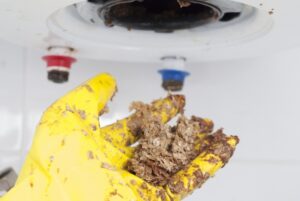There are so many benefits to tankless water heater systems. They’re extremely efficient, lowering your utility costs. They’re incredibly effective, and you no longer have to wait for a large tank to heat up between family member’s showers. It can be easy to forget that, just like a tank or storage water heater, they still do need maintenance.
The maintenance that water heaters of either type receive includes flushing the system. Why do water heaters need to be flushed? Do tankless systems need flushing, too? Yes, they do, and we’ll tell you exactly why.
Your Water: A Geology Lesson
You may remember that water is made of hydrogen and oxygen. That’s all—just two hydrogen atoms stuck to one oxygen atom, so that models of this molecule look like a little Mickey Mouse logo. And if that’s all that there was in your water, your water heater wouldn’t need to be flushed at all.
But your water actually contains other things. That’s because water is an amazing solvent. Whenever it comes into contact with anything, it takes a little bit of that along with it as it keeps flowing. This is why it’s so good at washing things, but also why clothes fade after being washed many times.
On its journey to your home, your water has picked up a lot of extra molecules. Particles of dirt, sand, or silt might come to mind, and yes, those are present. There are also dissolved minerals. Just like water dripping through a cave, when the hydrogen and oxygen move on, those minerals can be left behind. In a cave, that can become stalactites. In your water heater, it’s called mineral scaling.
How Minerals and Silt Affect Your Water Heater
Minerals will build up anywhere the water touches. The scaling or layering of these minerals will occur all over the inside of the tank of a storage water heater. It will also occur in the water line leading out of the water heater. In a tankless system, the buildup will also be throughout the system, all along the insides of the piping.
Silt behaves differently. It settles, just like it would at the bottom of a pond. In a tank, it will blanket the bottom, sometimes causing uneven heating as pockets of hotter water are caught under the layer of silt. In a tankless system, it will still obey gravity, settling into the lowest portions of the system.
How Flushing Resolves the Problem
Running a mild, non-toxic solution through your water heater system will wash away all the silt and mineral scaling. The system will then be rinsed with fresh water, and it will be ready to use again. Flushing once a year is generally enough to prevent all kinds of problems, the most common of which is low hot water pressure.
Even if you don’t have hard water, or water with an especially high mineral content, this flushing is strongly recommended. If you do have hard water, you may find you need to have your system flushed twice a year to prevent severe low hot water pressure, which can lead to cold showers and struggling appliances. A water softening system is another option you can discuss with your plumber.
For maintenance, flushing a system, or any other questions about tankless water heaters in Clifton, NJ, don’t hesitate to reach out.
Contact MarGo Plumbing Heating Cooling Inc. today with any concerns about your plumbing!

